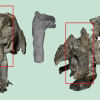Dinosaur blood vessels survived 80m yrs without fossilizing

Tiny, delicate vessels that carried blood through a duck-billed dinosaur 80 million years ago never fossilized and still contain the beast's tissue, a new study finds.
Researchers discovered the prize specimens on the femur (leg bone) of Brachylophosaurus canadensis, a 30-foot-long (9 meters) duck-billed dinosaur that was excavated in Montana in 2007.
But it wasn't immediately clear whether the blood vessels were made of organic matter originally from the dinosaur, or whether they had been contaminated over the years and were now made of bacteria or other components, reports Live Science.
Now, several tests show that the specimens are the original blood vessels, making them the oldest blood vessels on record to survive with their original components, the researchers told the Live Science.
The finding adds support to a growing pile of evidence that organic structures such as blood vessels and cells can persist for millions of years without fossilizing, they said. In fact, the blood vessels are only the latest part of the B. canadensis fossils the group is examining.
"The other major components of the bone from this dinosaur (bone matrix and bone cells) had already been studied, so we began studying the blood vessels in isolation," study lead researcher Tim Cleland, a postdoctoral researcher of chemistry at the University of Texas at Austin, told Live Science in an email.
The new project allowed the researchers "to focus on the vascular proteins that may hold more evolutionary information," said Cleland, who started the research while studying molecular paleontology at North Carolina State University.
To study the blood vessels, Cleland demineralized a piece of the leg bone and studied it with high-resolution mass spectroscopy. This technique uses an instrument to weigh and sequence proteins and peptides (chains of amino acids that are like proteins, but shorter).
One of the proteins within the vessel, myosin, is found in smooth muscles found in the walls of blood vessels, the researchers said.
In a separate test, they used antibodies to detect specific proteins in a thin slice of the blood vessels. The antibodies revealed the same proteins that the mass spectroscopy did, thus confirming the results.
The researchers also tested the bones of chickens and ostriches, both of which are living relatives of dinosaurs. In both the modern and ancient samples, the peptide sequences were the same as those found in blood vessels, the scientists said.
"This study is the first direct analysis of blood vessels from an extinct organism, and provides us with an opportunity to understand what kinds of proteins and tissues can persist and how they change during fossilization," Cleland said in a statement.
"This will provide new avenues for pursuing questions regarding the evolutionary relationships of extinct organisms, and will identify significant protein modifications and when they might have arisen in these lineages," he added.
Now that researchers have sequenced a large number of bird and crocodilian genomes, there should be more information about the proteins made by these creatures. This data may, in turn, help researchers study dinosaur proteins that have survived over millions of years, Cleland told Live Science.
"Part of the value of this research is that it gives us insight into how proteins can modify and change over 80 million years," Mary Schweitzer, a molecular paleontologist at North Carolina State University and co-author of the paper, said in the statement.
"It tells us not only about how tissues preserve over time, but gives us the possibility of looking at how these animals adapted to their environment while they were alive," she added.

 For all latest news, follow The Daily Star's Google News channel.
For all latest news, follow The Daily Star's Google News channel. 








Comments